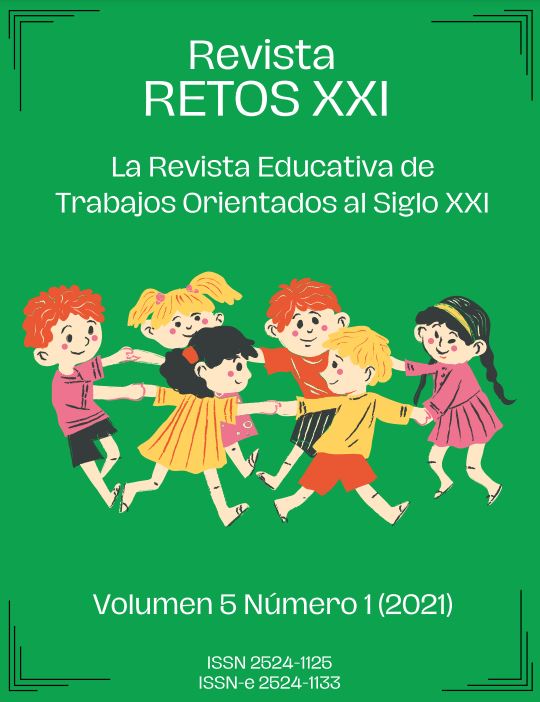Presence and permanence of non-classroom teaching from COVID
DOI:
https://doi.org/10.30827/retosxxi.v5i1.25268Keywords:
Non-presential teaching, online and off-line teaching, Synchronous and asynchronous teachingAbstract
The current moment will be a watershed in all dimensions of human history. It is due to the pandemic resulting from the spread of the SARS-COVID19 coronavirus worldwide. All sectors of society have been affected in one way or another, directly or indirectly. Education has been no exception. Measures adopted by most political systems, based on different restrictions on interactions between people, have brought about drastic and sudden changes in traditional education. Non-face-to-face teaching has been the most radical measure, which is still observed in many landscapes. It has demanded forced changes in roles of educational agents, working methods, resources of access to education, timing and development of activities, as well as modalities of evaluation. In the hope that humanity and science will succeed in overcoming this situation, we are invited to reflect on the new paths taken during this time, in order to learn from them and perpetuate the appropriate ones. For example, combining non-classroom teaching in the formal didactic framework of the education system for groups, contexts and moments in which it is more appropriate. This is the aim of this new monograph, which is being presented in the year in which we hope the pandemic will end, even if the virus coexists for some time to come.
Downloads
References
Booth, T., & Ainscow, M. (2000). Índice de inclusión. Desarrollando el aprendizaje y la participación en las escuelas. Centre for Studies on Inclusive Education.
Booth, T., & Ainscow, M. (2015). Guía para la educación inclusiva. Desarrollando el aprendizaje y la participación inclusiva. Organización de Estados Iberoamericanos
De Villalobos, M., & Echevers, B. (2019). La necesidad de investigación-acción como mejora educativa. Revista RETOS XXI, 3(1), 5-10. https://doi.org/10.33412/retosxxi.v3.1.2343.
Huertas, E., Biscan, I., Ejsing, C., Kerber, L., Kozlowska, L., Marcos, S., Lauri, L., Risse, M. Schorg, K., & Seppmann, G. (2018). Considerations for quality assurance of e-learning provision. European Association for Quality Assurance in Higher Education. https://enqa.eu/indirme/Considerations%20for%20QA%20of%20elearning%20provision.pdf
Lewin, K. (1946). Action research and minority problems. Journal of Social Issues, 2 (4), 34-46.
Pérez, R., Mercado, P., Martínez, M., Mena, E., & Partida, J.Á. (2018). La sociedad del conocimiento y la sociedad de la información como la piedra angular en la innovación tecnológica educativa. RIDE. Revista Iberoamericana para la Investigación y el Desarrollo Educativo, 8(16), 847-870. https://doi.org/10.23913/ride.v8i16.371
Rodríguez, A. (2017). Editorial: Caminando con sentido hacia la inclusión educativa mundial. RETOS
XXI, 1(1), 9-15. https://revistas.utp.ac.pa/index.php/retoxxi/article/view/1516
Rodríguez, A. (2018). Editorial: Expansión Postmoderna Tecnológica, Escuela Inclusiva Tecnológica. Revista RETOS XXI, 2(1), 5-12. https://doi.org/10.33412/retoxxi.v2.1.2055
Rodríguez, A. (2020). Editorial. A propósito de la diversidad de capacidades y necesidades. Revista RETOS XXI, 4(1). https://doi.org/10.33412/retosxxi.v4.1.2783
UNESCO (1994). Declaración Mundial de Salamanca y Marco de acción para las Necesidades Educativas Especiales. UNESCO.
Urdan, T.A., & Weggen, C.C. (2000). Corporate e-learning: exploring a new frontier. Hambrecht.
http://papers.cumincad.org/cgibin/works/Show?2c7d
Warnock, M. (1978). Special educational needs: report of the Committee of Enquiry into the
Education of Handicapped Children and Young People. Her Majesty’s Stationary Office.
Published
Versions
- 2023-04-16 (2)
- 2021-12-01 (1)
How to Cite
Issue
Section
License

This work is licensed under a Creative Commons Attribution-NonCommercial-ShareAlike 4.0 International License.












